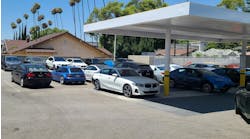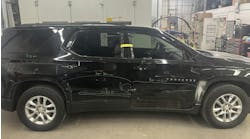Painters must know the limitations of clears they are spraying and the manufacturer recommendations for those products.
Clearcoat, the protective covering that is sprayed over basecoat, provides the needed protection from the elements that basecoat does not offer. It filters out harmful ultraviolet (UV) rays from the sun; it provides a deep shiny high gloss that customers demand, and, when done correctly, it helps make repairs undetectable. So what could be so hard about applying clearcoat?
As with many coatings, success in clearcoat application depends on numerous factors. The reduction of the clearcoat, the choice of catalyst, equipment set-up, the spray technique, and the painter's ability to evaluate that day's specific spray environment — and adjust the application to suit it — are each very critical. The painter must choose the correct method of application for each vehicle. He or she must take into consideration the color and location on the vehicle that is being sprayed, along with the end texture that needs to match. There must be the proper minimum of clear thickness when the vehicle is delivered without exceeding the maximum overall film thickness. Painters must know the limitations of the clear they are spraying and the manufacturer's recommendations for the clear they have chosen.Let us start with the staggering array of clears that are available today. I do not mean all the clears available from all the manufacturers, which can be overwhelming. I mean within the paint line your body shop has chosen to use there can be, and probably exists, a large number of options for clears. Some are designed for baking conditions, while others are for non-baking, spray applications. There are fast-drying clears for small areas and fast-drying clears for larger areas, UV-cured clears, clears to be applied over waterborne basecoat and even clears used for blending. The number of clears available to paint technicians is so great that most narrow it down to two or three different types of clears and just use them. Most painters find that to be the most efficient way to handle the process.
So which of these clears should a painter choose? In a production shop, a very fast clear for cutting in parts and applying to the small jobs of no more than three panels may just be the workhorse of the shop. In fact, a hyper-cure clear can turnout to be one of the best ways that each booth can paint more vehicles per day. Hyper-cured clears need very little flash time between coats and thus can be applied very quickly. Coupled with the fast curing time to dry, the vehicle can be taken out of the paint booth very rapidly and another vehicle can be placed inside. Paint booths are not making money for the business while a vehicle is baking. Consequently, the faster a vehicle moves out of the spray booth and the next one is placed inside, the greater the potential profit for the business.With some applications, however, a hyper-cure clear may not be the best choice. Most of the paint companies that make a hyper-cure clear do not recommend its use with large applications. The recommendation is often that these very fast curing clears should be used when spraying three panels or fewer. Since the products gas out and start to cross-link so rapidly, painters are not able to paint more than three panels before they should be applying the second coat. Otherwise dry or poor flow-out results.
Gun choice and its set-up also have become critical when spraying high solids clearcoats. With transfer efficiency being a concern in many states, high volume low pressure (HVLP) spray guns have been mandated. New clears with their high solids and thicker viscosity are more difficult to atomize. In the past, painters depended on using high pressures to atomize thicker paints, with the trade-off being that as the pressure goes up, the transfer efficiency goes down. Now that paint guns should not exceed 10 psi at the tip, pressure no longer can be used to properly break up the paint. To combat this problem, painters must be aware of and use the needle nozzle setup more judiciously than they did in the past. Many paint manufacturers are now calling for tip recommendations of 1.2 to 1.3. Some even call for smaller recommendations, such as .8 to 1.5.Though these sizes may seem extreme, remember the physics of atomization: large amounts of thick coatings must have large amounts of air pressure to combat the surface pressure of the coating and reduce it to a small mist (atomization) for painting. If we can no longer use high pressure to break up thick paints coming out of a gun very fast, we must reduce the amount of paint coming out of the tip so that the amount of air available can properly atomize the paint. Thus, the use of smaller tip sizes is the answer. With smaller amounts of paint coming out of the gun, the available air can break up the paint, atomizing it properly for smooth application.
Painters must keep in mind the recommendations of the paint companies and spray gun manufacturers. Many painters prefer looking online to find a paint maker's recommendations for their specific product that will be sprayed through a specific gun. This way, the optimal tip setup can be found for the gun and coating they are using.One challenge of applying clearcoat is that the texture of the vehicle must be matched so that an invisible repair can be produced. Nearly all painters hate any visible orange peel in their clearcoat. But if the vehicle was originally painted with visible texture, to correctly match the vehicle the texture also must be matched.
Reduction/mixing
In the past, most clears were reduced by adding at least some reducer before they were applied. A painter could choose the proper reducer for the environmental conditions, such as temperature, airflow, humidity, etc. Modern high-solids clearcoats often do not recommend using any reducer, but provide the painter with options of the type or "temperature" of hardener that they can use to match conditions. These different hardeners do not reduce the viscosity or thickness of the clearcoat that is being applied, but they allow the paint to remain "open" longer (not harden as fast), thus allowing for a better flow-out.Painters should read, understand and follow the paint maker's recommendations when choosing different hardeners, because they may have longer flash times between coats for each different hardener. Choosing the proper hardener and matching it to the spraying conditions is one of the most critical aspects of worry-free professional clearcoat application.
Some painters have assumed that to combat the difficulties of high solids clearcoats, if they just add some reducer (thus reducing the viscosity of the clearcoat) they will have smoother, texture-free paint application. And though this seems logical, one problem is "solvent die-back," a condition in which the clear looks highly glossy and smooth when first painted, but following the cure time the gloss dies back. The finish becomes dull and cannot always be buffed to the required shine. Therefore, it may need to be re-painted to obtain the desired finish quality.Application technique
Once the technician has chosen the type of clearcoat for the job, the gun set-up for the type of clearcoat being sprayed, and the correct hardener for the environmental conditions, the technician must be all set to apply the clear, right? Not quite yet. Next, the painter must decide the best application technique for the given application. At this point, knowing the paint maker's recommendations becomes even more critical than in the earlier stages of preparation, if that is possible.
Some paint manufacturers call for the first coat of clear to be sprayed over the basecoat with it extending just a slight bit beyond the base. The recommended flash time must be observed; then a second coat is applied to the complete previously prepared panel. By doing this, the painter knows that over the newly applied basecoat there will be two full medium-wet coats, thus supplying the 2 mils of clearcoat that is needed for UV (ultraviolet) protection. Over the remainder of the panel where there is already a 2-mil thickness of protective clearcoat, the painter applies just one coat, thus using less material and speeding up the repair process.Some paint manufacturers recommend what they call a "coat and one half." That is, a painter will spray a light mist coat over the entire repaired area and with no flash time will come back with a second application of clearcoat. This method will also apply 2 to 2.5 mils of clearcoat, but because there is no between-coat flash time, it can be applied faster. Be advised that if this method is the one recommended by your paint company and you are switching from a traditional two-coat application, it may take some time to get used to the 1.5-coat method.
One of the most critical things a painter must know about the particular spray method he or she is using is that 2 mils of clear must remain following any polishing that may be required. If the painter knows that the particular spray technique applies 2.5 mils of clear, a third coat will never be needed, even if dirt or imperfections need to be buffed out after painting. Painters in the past would see dust in the paint and know that they would need to buff to get the dust particles out. Because of this, they would apply a third coat of clear so they would have some "clear to buff to," and nearly all the time would be exceeding the necessary?film thickness. The end result was that they were wasting time, material and money.Polishing
Polishing is a repair. It never makes money for the shop and for the most part it cuts back on a paint department's profits. Painters should at all cost try to keep from producing imperfections that need to be buffed out. If there are small bits of dirt or dust, the surface should be nibbed out. Then as small an area as possible can be polished. Polishing will be needed for a percentage of vehicles that come through the shop, but it can and should be kept to a minimum.Clearcoat at first seems like a straightforward, worry-free coating to apply. But many things must be taken into consideration when applying clears so that an invisible repair can be accomplished. Some precautions should be taken when choosing the two or three clears that will be available to a painter for specific conditions. Having a gun set-up for clear and only clear will cut down on production problems. Keeping the vehicle, the painter, and the paint booth clean and dirt-free also helps to keep buffing to a minimum. Then, choosing the proper hardeners for each day's spray conditions will tailor the coating to that day's spray environment, and thus produce a consistent outcome, even though circumstances and conditions change.




